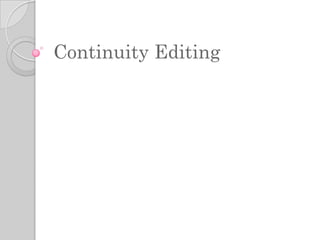
Continuity editing
- 2. What is Continuity Editing? Continuity Editing is a system which is used in order to maintain a clear and continuous narrative. To maintain continuity, an individual must follow a certain set of rules.
- 3. The Importance of Continuity Editing In modern media, continuity editing is an important part of nearly every major film and television company. Originally, it was predominantly associated with big Hollywood films. The purpose of continuity editing is to present a scene in such a way that editing is undetected or “invisible”. This prevents the audience from becoming confused and distracted by shots that do not match up to each other, or shots that lack spatial awareness.
- 4. The Rules of Continuity Editing Establishing Shot-This shot can present a complete view of the area and provide the spatial relationship between key characters or objects. By having an establishing shot, the audience are less likely to become disorientated. 180 Degree Rule-This states that the camera must stay on only one side of the action and objects in a scene. By using the 180 Degree rule, the audience will hardly develop any sense of disorientation.
- 5. The Rules of Continuity Editing Shot/Reverse/Shot-In a simple Shot/Reverse/Shot, the camera alternates between shots that show one person at a time (usually during a conversation). This makes it easier for the narrative structure of the plot to flow smoothly, preventing the audience from becoming confused. Re-Establishing shot-This is used to refresh the audience’s memory of the layout of the scene and again, prevent confusion by allowing them to follow the storyline.
- 6. The Rules of Continuity Editing Match on Match Action-This is commonly used as it subtly embeds cuts in the middle of a scene. This is used to conceal the fact that a cut has been used, and keep the flow of the scene running smoothly. Eyeline Match-Similar to Match on Match Action, an Eyeline Match is typically used to ensure spatial relativity is maintained, and also conceals the use of a cut.